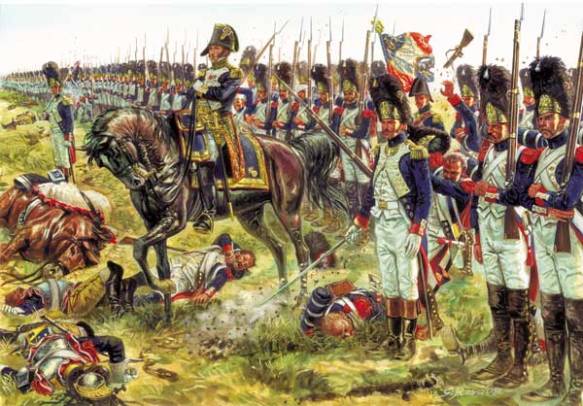Quality of Napoleon’s army.
One of the most significant developments in command and control during the Revolutionary and Napoleonic Wars was the introduction of the combat division and army corps. The increasing size of armies during the eighteenth century as well as multiple theatres of war required administrative reorganization of European armies. Generally, the standard military unit was the infantry regiment, composed of one or two combat battalions and a depot battalion. Cavalry regiments also remained the standard, although their squadrons could be divided among armies in different theatres.
The army commander therefore contended with controlling numerous battalions and squadrons on the strategic, operational and tactical level. This created an enormous burden for army staffs, who had the responsibility for keeping track of the units within an army, keeping them supplied and ensuring that orders were properly disseminated in a timely fashion. This was no easy task. The coordination of tens of thousands of men on campaign often led to confusion and inefficiency. To reduce the difficulty, European armies were often organized into ad hoc wings, columns (Abteilungen) , divisions and brigades whose composition depended entirely on the mission at hand. There was no standardization of army organization above the regiment.
In 1759, during the Seven Years War, the Duc de Broglie (1718-1804) established combat divisions within French Army, but these were temporary formations. Also during the mid-eighteenth century, the French army introduced the administrative military division. France was divided into military regions and each general of a division was responsible for the regiments garrisoned within his region. This organization, however, did not translate into the standing combat division that emerged during the French Revolutionary Wars (1792-1802), but it provided the foundation for that development.
Pierre de Bourcet (1700-80), a staff officer, advocated the introduction of the division as a standard formation in his Principes de la Guerre des Montagnes, written in the 1760s-1770s. Divisions would enable an army to advance along parallel routes and unite rapidly for battle. The formation would facilitate greater efficiency on campaign and provide for the rapid movement of larger numbers of troops over great distances, as opposed to an army using a single road, moving slowly and encumbered by supply trains. To that end, another French military theorist, the Comte de Guibert (1743-90), argued in his Essai general de tactique of the early 1770s that armies should dispense with their supply trains in order to increase their flexibility and mobility.
‘March Divided, Fight United’
The division began to develop in the mid-eighteenth century as a means of improving an army’s strategic mobility and its ease of command. A general commanding an army did not have to keep track of each battalion and squadron but merely of his divisions. Meanwhile, the divisional generals were responsible for controlling their respective regiments. Indeed, while the French explored divisional organization they also introduced the infantry brigade – a unit formed of two infantry regiments. Prussia, too, organized its army into brigades but did not adopt the combat division. What made the French division unique was the integration of artillery and cavalry into the table of organization. Typically, artillery and cavalry were under the direct control of the army commander, who apportioned it to his subordinates as needed. By integrating artillery and cavalry into the divisional structure, the French possessed greater firepower and reconnaissance at a lower level. Divisions could march divided, engage the enemy and have adequate support for a short period until reinforced by other divisions. The principle is often cited as ‘march divided, fight united’.
During the French Revolutionary Wars, the increased size of campaign armies compelled the Revolutionaries to introduce the combat division as a permanent entity within army organization. Each division comprised two infantry brigades, a cavalry detachment – a squadron or regiment and an artillery battery. At times, generals gave command of multiple divisions to a single subordinate, dependent upon the plan of operations. General Andre Massena (1758-1817), for example, led two divisions of Napoleon’s Army of Italy in 1796; General Kleber also led two divisions in Belgium in 1794.
Napoleon built upon the divisional foundation to expand the organizational system, introducing the corps d’armée. These bodies existed during the revolution but in a temporary state. Each corps comprised two or three infantry divisions, a cavalry brigade (later division), divisional artillery and a corps artillery reserve. Engineer companies and a corps staff were included to make the organization a self-contained fighting unit of 20,000-30,000 men.
A marshal of France, and occasionally a general of division (general de division), commanded a French corps after 1804. Each divisional commander, his brigadiers and the regiments comprising the corps remained part of the corps from campaign to campaign. A French corps also, like a Roman Legion, generally remained in a specific European theatre. Thus Marshal Louis Davout’s vaunted III Corps of the Grande Armée retained its composition from its establishment in 1803 through to 1812 and was based in Germany.
Ideally, French corps operated on independent axes of advance but within mutual support of another. This allowed Napoleon to coordinate the Grande Armée on campaign with greater ease than his opponents could control their armies; the latter rejected the corps system, preferring the traditional column, or Abteilung. During the 1806 campaign against Prussia, Napoleon deployed his army into essentially three columns of three corps, the bataillon carré. Each corps was a half-day march from the supporting corps and a full day from all corps in any direction.
Prussia and Austria adopted the divisional system by the early nineteenth century, but their divisions remained largely administrative, and no standing combat divisions came into being until 1809 and thereafter. The Russians did develop military divisions and combat divisions by 1805, but they were incredibly cumbersome and lacked the appropriate staff to manage the brigades and regiments adequately. In Britain, brigade and divisional organization were ad hoc, with formations established for specific expeditions.
